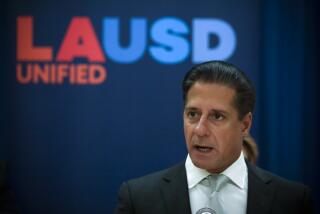Question of Funding Clouds Simi School Expansion
- Share via
The Simi Valley Unified School District is once again considering the creation of middle schools and four-year high schools in a plan that has wide support but uncertain funding, officials said this week.
A nearly $500,000 proposal is scheduled to come before the Board of Education Tuesday at a meeting expected to draw a large crowd because of community interest in the plan.
School officials, parents and instructors said there seems to be general acceptance of the proposed change, which could take effect as early as September.
But the trustees’ decision is expected to hinge largely on finances, said board President Lew Roth and the district’s senior director of curriculum and instruction, Peter Rogalsky.
“Money is the key issue,” Rogalsky said Wednesday. “What the board is going to have to struggle with is whether it’s something we can afford within the limitations of our budget.”
Despite trends and a 1987 state study that found the academic performance of sixth-, seventh- and eighth-graders tends to sag and can be improved by middle schools with special programs, the Simi Valley school system remains in a minority of districts with conventional junior high schools. According to state records, there are 803 middle schools statewide compared to 163 junior high schools.
Under Simi Valley’s proposal, elementary schools would include kindergarten through fifth grade instead of kindergarten through sixth grade. Four middle schools would include sixth grade through eighth grade, replacing four junior high schools that now have seventh grade through ninth grade. The city’s two high schools would include ninth grade through 12th grade instead of 10th grade through 12th.
Rogalsky said that given the city’s current demographics, the new arrangement would also ease swelling enrollment in the elementary schools while filling under-used high schools. Split sessions in the high schools would not be necessary, he said, although Simi Valley High School’s student population is expected to increase from about 2,200 to 2,700 and Royal High School’s from about 1,900 to 2,500.
The district would make a one-time expenditure of $358,000 to add portable classrooms, lockers, furniture and other equipment in the high schools, Rogalsky said. The proposed changes would add about $126,000 a year in operating costs for additional teachers and guidance counselors in the middle schools, he said.
The additional funding would either come from the state, which provides the majority of the school system’s current $75-million operating budget, or from the district’s reserves, Rogalsky said. The district serves about 18,500 students.
The $484,000 proposal has been scaled down considerably from a $1-million proposal rejected by the board a year ago because of its cost, Roth and Rogalsky said. A similar plan in the late 1970s failed after voters defeated a bond measure, Rogalsky said.
Chief among the cost-saving measures--and one of the most controversial aspects of the proposal--is the elimination of four assistant principals, or one in each of the four proposed middle schools. The junior highs now have a principal and two assistant principals each.
Rogalsky said no layoffs were expected because retirements would enable the district to reassign affected administrators. Athletic coaches and music teachers, whose junior high school jobs would also be eliminated, could be similarly transferred, he said.
But an outspoken critic of the plan, Sequoia Junior High School coach Rich Griffin, said the staff reductions would defeat the purpose of middle schools, which is to give vulnerable youngsters increased attention.
“At a time when kids need guidance and the personal touch, they’re going to overcrowd the high schools and understaff the middle schools,” said Griffin, who coaches boys’ basketball.
As proposed, the middle schools’ sixth-graders would spend most of their six-period day studying a core curriculum with one teacher--as they did in elementary school--and then take two periods of exploratory courses in computers, foreign languages or the performing arts. The idea, said Rogalsky, is to gradually introduce the students to specialized classes.
Seventh-graders would spend a smaller part of their day with one teacher and then switch classes for as many as four periods. Eighth-graders would study a variety of courses under different teachers, as they do now in junior high school.
More to Read
Sign up for Essential California
The most important California stories and recommendations in your inbox every morning.
You may occasionally receive promotional content from the Los Angeles Times.













